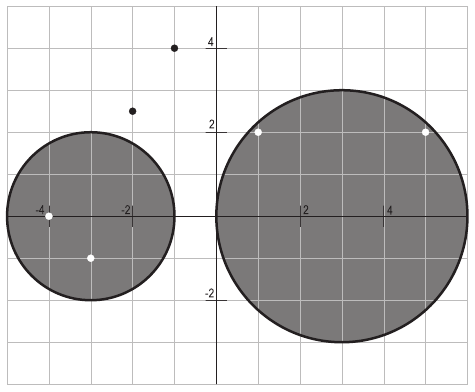Programming contestsECN selejtező programozó csapatverseny, 2012. május 6.
May 6, 2012, 10:10 AM –
May 6, 2012, 3:10 PM
|
Air Strike
General Gee is the commander of a military base. He has just received alarming news from one of his spies: the enemy is preparing an air missile strike. The base contains two magnetic towers. When activated and given sufficient power, each of the magnetic towers creates a powerful horizontal magnetic disk. If any missile passes through this disk, it deflects away from the base. Although those towers seem to be an excellent air defense method, there is a problem: The area of the disk generated by a tower is proportional to the amount of energy it receives. The base has enough power plants to generate a certain amount of energy, which has to be divided among those two towers. That means that the total area of the two disks generated by the towers should not exceed the total energy generated by the power plants. Fortunately, the spy was able to know the exact target coordinates of the incoming missiles and he reported them to General Gee. The General needs your help in distributing the energy on the two magnetic towers to minimize the number of missiles that will not get deflected by the magnetic towers and therefore will hit the base. You may assume the following:
- The towers have different heights and therefore there are no problems associated with the magnetic disks interfering with each other.
- A missile will deflect if it passes through the magnetic disk of a tower or even if it just touches its boundary.
- A missile hitting a tower (landing exactly on its location) will deflect, even if the tower is not given any energy.
- All incoming missiles will go down simultaneously at the exact instant; therefore, there will not be any time available to redistribute the energy amongst the two towers during the strike.
Input Specification
Input consists of several test cases. Each test case is specified on N + 2 lines. The first line contains an integer (1 ≤ N ≤ 1000) representing the number of missiles. The second line contains 5 real numbers X1, Y1, X2, Y2 and T: (X1, Y1) are the coordinates of the first tower, (X2, Y2) are the coordinates of the second tower, and T (T ≥ 0) is the total amount of energy generated by the power plants (the total area of the two magnetic disks). Each line of the remaining N lines contains two real numbers representing the landing coordinates of a missile.
The absolute value of all the given real numbers is less than or equal to 100 and may include a decimal point followed by up to 3 digits. Any two consecutive numbers on the same line are separated by one or more whitespace characters. Zero or more blank lines may appear between test cases.
The last line of the input file is made up of a single zero.
Output Specification
For each test case, print the following line:
k. M
Where k is the test case number (starting at one), and M is the minimum number of missiles that will NOT be deflected in the best distribution of energy among the two towers. Use π = 3.141.

Sample Input
6-3 0 3 0 40.833-1 4-2 2.51 25 2-4 0-3 -120 0 1 1 00 01 10
Output for Sample Input
1. 22. 0